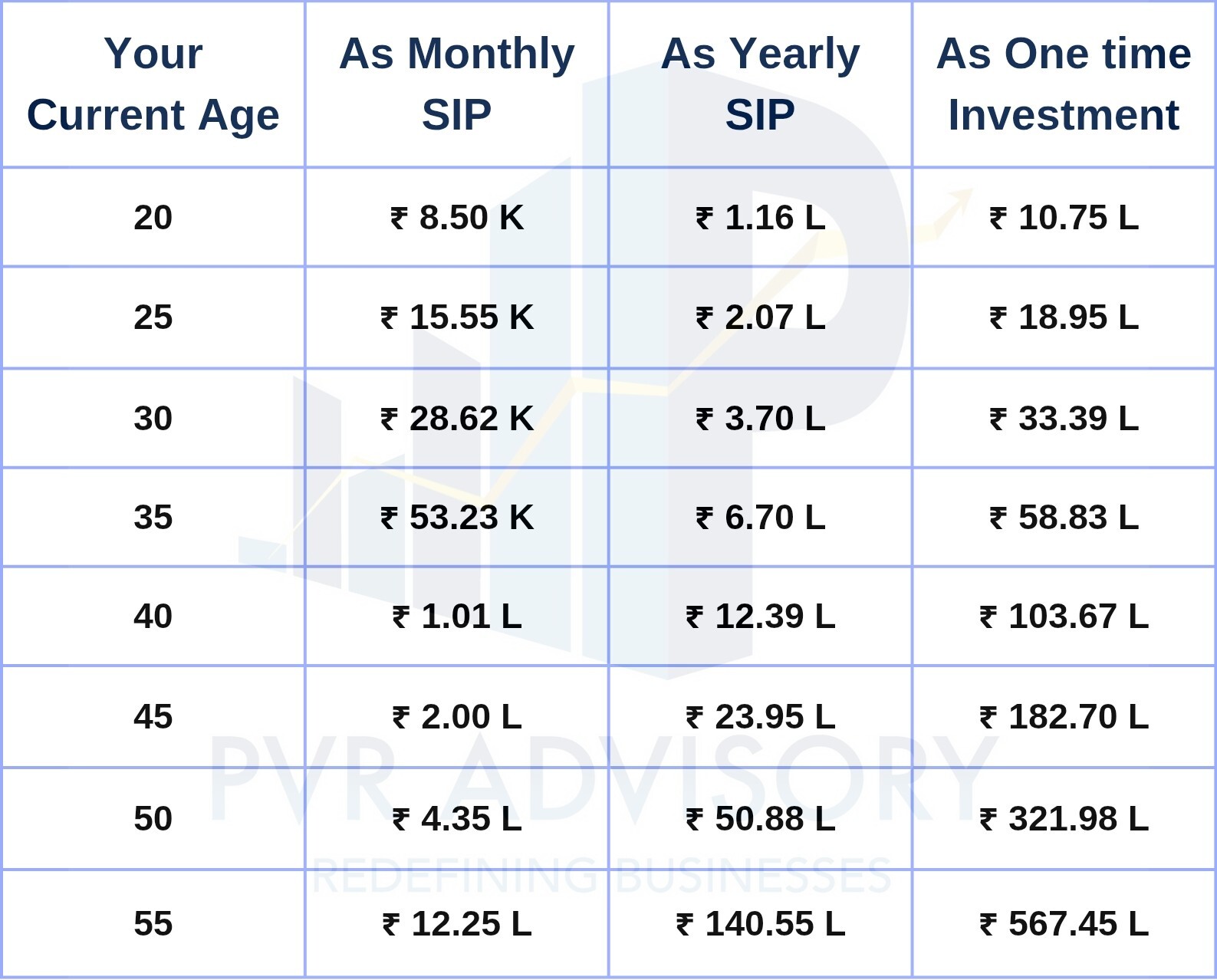Retirement isn’t just the end of working life — it’s the beginning of financial freedom. Whether you want to relax, travel, pursue hobbies, or spend time with family, having a strong retirement corpus gives you the freedom to live on your terms.
For many Indians, a retirement corpus of ₹10 Crores is a solid target. The image below gives a clear roadmap on how much you need to invest at different ages to reach that target by age 60 — assuming a 12% annual return (CAGR).

📌 Note: This assumes your investments grow at a 12% CAGR and are continued consistently until the age of 60.
🔍 Key Learnings from This Table
1. Start Early, Invest Less
Starting at 20 requires just ₹8,500/month, while starting at 40 requires ₹1.01 Lakh/month. That’s the magic of compounding — the earlier you start, the less you need to invest.
2. Delay Costs More
Every 5–10 years of delay more than doubles or triples the required investment. Waiting to start later puts unnecessary pressure on your finances.
3. SIP vs Lump Sum
You can reach your goals through monthly SIPs, yearly contributions, or a one-time investment — the choice depends on your cash flow and investment style.
💡Flexible Interpretations to Use This Table Smartly
1. Scale Down for Smaller Goals (₹5 Cr, ₹1 Cr, etc.)
The table is based on a ₹10 Crore target. If your target is smaller, just scale the numbers down proportionally.
Example:
At age 30:
₹10 Cr requires ₹28,620/month
₹5 Cr = ₹28,620 ÷ 2 = ₹14,310/month
₹1 Cr = ₹28,620 ÷ 10 = ₹2,862/month
Apply the same for yearly SIPs or lump sum amounts.
2. Plan for a Specific Amount in X Years
Want to accumulate a specific amount (say ₹1 Cr) in X years?
Use this smart trick:
Find the row of a person aged (60 – X) and divide that row’s values by 10 to get the investments needed for ₹1 Cr in X years.
Example:
₹1.01 Lakh/month for ₹10 Cr
₹1.01L ÷ 10 = ₹10,100/month for ₹1 Cr
This technique works for any goal with a defined time horizon.
3. Want to Retire Early? Adjust Your Horizon
If your goal is early retirement (before age 60), use the same method.
If your current age is A and your retirement target is in Y years,use the row for age (60 – Y) to find the required investment.
Example:
Monthly SIP = ₹1.01 Lakh for ₹10 Cr
For ₹1 Cr = ₹10,100/month
This makes planning early retirement both practical and precise.
4. This Table Works for Any Large Financial Goal
Though designed for retirement, the logic applies to other big goals:
🏠 Buying a house
🎓 Child’s education
🛑 Financial independence
✈️ Dream business or world travel
Just adjust the target amount and time horizon as needed.
⚠️ Important Disclaimer
This is an illustration, not a guaranteed return. Real returns may vary depending on:
Market performance
Asset allocation (equity, debt, etc.)
Inflation and lifestyle needs
A 12% CAGR is achievable through equity-oriented investments over the long term, but always consult a SEBI-registered advisor for personalized planning.
🧠 Final Words: Your Future Is in Your Hands
Planning for retirement or any big financial goal is not optional — it's essential. The sooner you start, the easier the journey. Even if you’re 35, 40, or 50 — start now.
At PVR Advisory, I help you craft a plan that matches your goals, risk appetite, and time horizon. Whether you want ₹10 Cr at 60 or ₹1 Cr in 15 years, I'm here to guide to achieve it smoothly.
📞 Get Started Today
💬 Reach out to PVR Advisory – Your trusted SEBI Registered Investment Advisor & Research Analyst.
“Start investing now, so your future self can live without financial stress.”
Happy Investing!!!
If you find it useful, please share it with your friends, family, or anyone who needs retirement guidance. Let’s help more people secure their future! And kindly let me know if you have doubts or your opinion on the article in the comments below.
Disclaimer: Investments in securities market are subject to market risks. Read all the related documents carefully before investing. Registration granted by SEBI, membership of BSE and certification from NISM in no way guarantee performance of the intermediary or provide any assurance of returns to investors.



